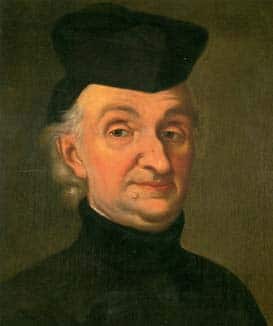
Vincenzo Riccati
Vincenzo Riccati, S.J. (January 11, 1707 to January 17, 1775) Vincenzo Riccati was an Italian mathematician, physicist, and Jesuit priest of Venetian birth. His father, Jacopo Riccati (1676 to 1754) was himself a mathematician of note, after whom the Riccati equation, a very important type of differential equation, is named. Vincenzo entered the Jesuit order in 1726. After teaching at several Jesuit colleges and completing his theological studies in Rome, he was assigned in 1739 to teach mathematics at the College of St. Francis Xavier in Bologna, where he remained for the next thirty years. Vincenzo Riccati’s lasting contribution to mathematics was to introduce the “hyperbolic functions” into mathematical use, which he did in the first volume of his treatise Opusculorum ad res physicas et mathematicas pertinentium, published in 1757. He also gave these functions the names “hyperbolic sine”, “hyperbolic cosine”, etc., by which they are known today, and he also introduced a notation for them (sh x, ch x, and so forth) that is still often used. The hyperbolic functions were also introduced, independently of Riccati, by the German mathematician Johann Heinrich Lambert in 1761. Lambert’s notation for them (sinh x, cosh x, and so forth) is the most commonly used. Hyperbolic functions are related to hyperbolas in the same way that the ordinary trigonometric functions (sine, cosine, etc.) are related to circles. In fact, there is a close relation between the hyperbolic and circular functions (for example, sin (ix) = i sinh x, where i is the square-root of -1). The hyperbolic functions arise very often in mathematics and the physical sciences. A place where they arise in everyday life is as the shape of a chain freely suspended between two points, called the “catenary” curve (from the Latin word for chain), which is just the shape of the graph of the hyperbolic cosine function. Vincenzo Riccati’s younger brother Giordano Riccati (1709 to 1790) did significant work in physics. He was the first person to measure the “Young’s modulus” (a measure of elasticity) of materials, 25 years before the work of the English physicist Thomas Young, after whom the property is named.
Explore Other Scientists
It is our hope that this curated set of biographies will be useful to teachers, students, and the general public.